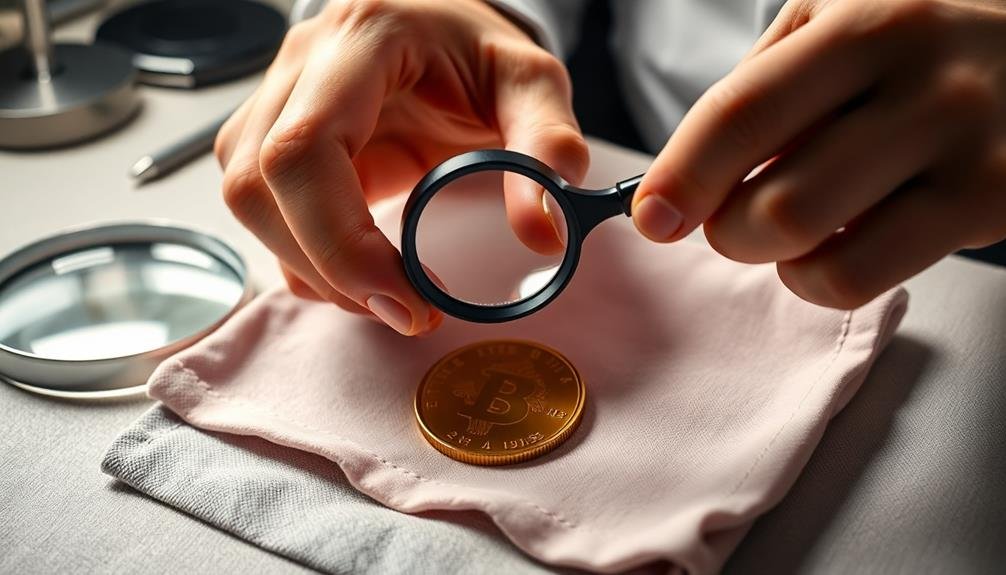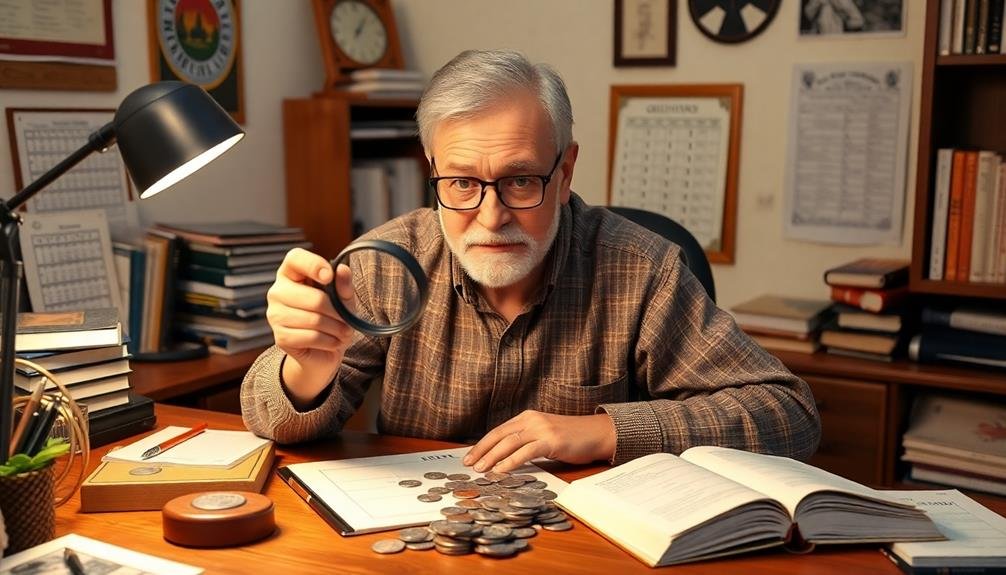For anxious collectors, coin grading doesn't have to be stressful. First, invest in quality magnification tools to examine your coins in detail. A 5x to 10x magnifier or digital microscope can make a world of difference. Second, consult reference materials like specialized books, grading guides, and reputable numismatic websites to build your knowledge base. Finally, practice gradual self-grading by starting with easier coins and progressing to more challenging specimens. Compare your grades with professional services and keep a journal to track your progress. By following these techniques, you'll gain confidence and expertise in no time. Discover how these methods can transform your coin grading experience.
Use Magnification Tools

To get the most out of your coin grading experience, you'll need to invest in quality magnification tools. A good magnifying glass or loupe is essential for examining coins in detail. Look for a magnifier with at least 5x to 10x magnification power. For more serious collectors, consider a digital microscope that can connect to your computer, allowing you to view and capture high-resolution images of your coins.
When using magnification tools, make sure you're working in a well-lit area. Natural daylight is best, but if that's not available, use a bright, adjustable desk lamp. Hold the magnifier close to your eye and move the coin, not the magnifier, to focus. This technique will help you maintain a steady view and reduce eye strain.
As you examine the coin, pay attention to key areas like the coin's surface, edges, and any intricate design details. Look for signs of wear, scratches, or other imperfections that might affect the coin's grade.
Consult Reference Materials
When it comes to accurate coin grading, consulting reference materials is essential. You'll find a wealth of information in specialized books, online resources, and grading guides that can help you make informed decisions about your coins' conditions.
Start by investing in a thorough coin grading guide that covers the specific types of coins in your collection. These guides often include detailed descriptions and high-quality images of coins at various grade levels, allowing you to make side-by-side comparisons.
Don't overlook online resources, such as reputable numismatic websites and forums. These platforms often provide up-to-date information, expert opinions, and discussions on grading standards. You can also find digital archives of auction catalogs, which can be invaluable for researching rare coins and their market values.
Consider subscribing to numismatic publications or joining coin collecting organizations. These sources often provide in-depth articles on grading techniques, market trends, and new discoveries in the field.
Practice Gradual Self-Grading

As you begin your coin grading journey, it's crucial to practice gradual self-grading. Start with easier-to-grade coins and work your way up to more challenging specimens.
Begin by focusing on the most obvious features, such as overall wear and luster, before moving on to finer details.
Set aside a dedicated practice session each week, grading a small batch of coins from your collection. Compare your grades to those assigned by professional grading services or experienced collectors.
Don't be discouraged if your grades don't match perfectly; consistency is key.
As you gain confidence, challenge yourself with more difficult coins. Pay attention to subtle differences between grade levels and practice identifying key areas that determine a coin's grade.
Use a magnifying glass to examine mint marks, date details, and surface imperfections.
Keep a grading journal to track your progress and note any recurring challenges. Join online forums or local coin clubs to discuss grading techniques and get feedback on your assessments.
Frequently Asked Questions
How Do I Handle Rare Coins Without Damaging Them?
You should handle rare coins with clean, lint-free gloves to avoid skin oils. Hold them by the edges, never touch the surface, and use soft, padded surfaces. Store them in protective holders and avoid harsh cleaning methods.
What's the Best Lighting Setup for Accurate Coin Grading?
You'll want a bright, adjustable LED light source with a color temperature around 5000K. Position it at a 45-degree angle to the coin's surface. Use a neutral background and avoid glare for the most accurate grading results.
Are There Professional Coin Grading Services I Can Use?
Yes, you can use professional coin grading services. They'll provide expert evaluation and authentication. Popular options include PCGS, NGC, and ANACS. You'll send your coins to them, and they'll return them in sealed, tamper-evident holders with assigned grades.
How Often Should I Reassess My Coin Collection's Grades?
You should reassess your coin collection's grades every few years. If you've acquired new pieces, handled coins frequently, or noticed environmental changes, it's wise to check sooner. Market fluctuations can also impact grades, so stay informed.
Can Cleaning Improve a Coin's Grade or Value?
No, cleaning won't improve your coin's grade or value. In fact, it'll likely decrease both. You should never clean your coins. Collectors and graders prefer coins in their natural state, even if they're tarnished or dirty.
In Summary
You've now got three simple techniques to ease your coin grading anxiety. Remember, it's okay to start small and build your confidence gradually. Use magnification tools to spot details, consult reference materials to compare your coins, and practice self-grading at your own pace. Don't be too hard on yourself; grading is a skill that takes time to develop. With patience and these stress-free methods, you'll become a more confident collector in no time.





Leave a Reply